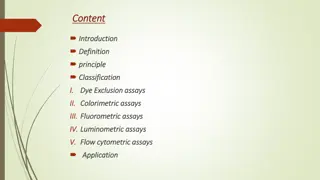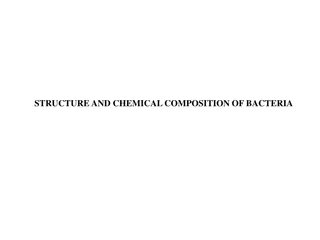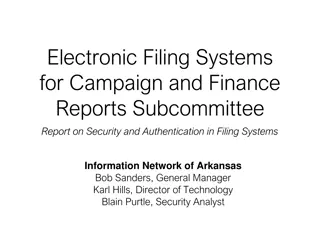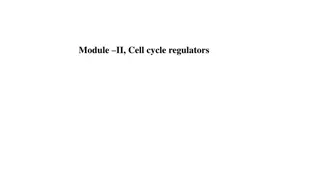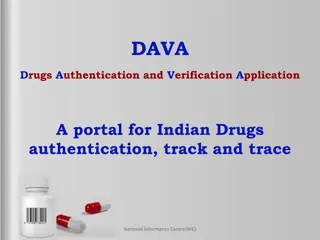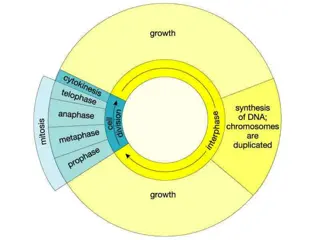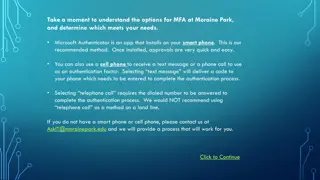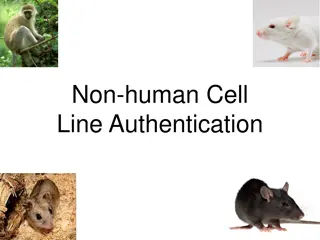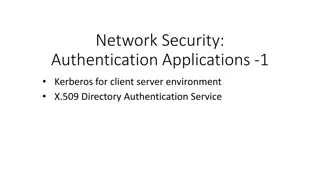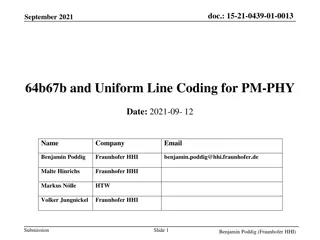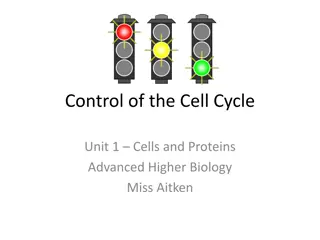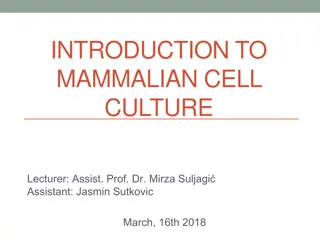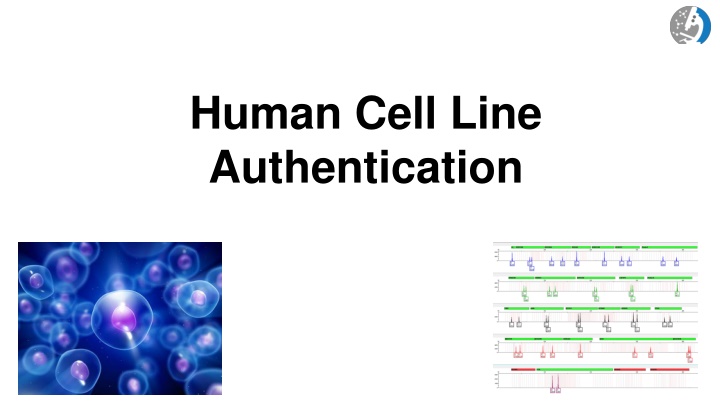
Cell Line Authentication: Importance, Challenges, and Solutions
Explore the critical issue of human cell line authentication, including challenges with misidentification, actions taken to address the problem, recommended testing practices, and available databases for verification. Stay informed to ensure the integrity of research findings and data reliability in biological studies.
Download Presentation

Please find below an Image/Link to download the presentation.
The content on the website is provided AS IS for your information and personal use only. It may not be sold, licensed, or shared on other websites without obtaining consent from the author. If you encounter any issues during the download, it is possible that the publisher has removed the file from their server.
You are allowed to download the files provided on this website for personal or commercial use, subject to the condition that they are used lawfully. All files are the property of their respective owners.
The content on the website is provided AS IS for your information and personal use only. It may not be sold, licensed, or shared on other websites without obtaining consent from the author.
E N D
Presentation Transcript
Human Cell Line Authentication
Aiding Cell Line Authentication Applied Genetics Issue was elevated with an open letter to the Secretary of Health and Human Services in July 2007 Nature 457 (2009) 935-936 An ATCC committee was formed to determine protocols and policies and look into database issues Forensic DNA Short Tandem Repeat (STR) typing has aided work in this area Thousands of biology labs use cell lines, yet many do not know that between a fifth and a third of the lines in common use may not be what they seem the crisis can be solved by analyzing repository cell lines using DNA fingerprinting- short tandem repeats (STRs)
Unresolved Problem Today Published October 12, 2017: We found 32,755 articles reporting on research with misidentified cells, in turn cited by an estimated half a million other papers.
Action Taken ANSI Standard (ASN-0002): Authentication of Human Cell Lines: Standardization of STR Profiling was published in 2012 Numerous journals and granting agencies are now requiring authentication of cell lines prior to publication and funding The FDA has instituted a requirement for the authentication of cell lines used to produce pharmaceuticals 21 CFR211.160 (b) 21 CFR 610.18 (b) NIH has revised guidelines to applications for funding and provided guidelines for reporting Enhanced Reproducibility through Rigor and Transparency (effective Jan. 25, 2016) Notice Number: NOT-OD-15-103 NIH Rigor and Reproducibility: Principles and Guidelines for Reporting Preclinical Research and Endorsement by major journals
When to Test? It is recommended to authenticate cell lines: upon receiving a cell line and prior to freezing down master stocks before beginning a large study ($$) prior to publication if unexpected changes are observed in the culture (morphology, doubling time, etc.) unexpected experimental results (reproducibility)
STR Databases Available Database for cross-contaminated or misidentified cell lines International Cell Line Authentication Committee (ICLAC) (http://iclac.org/databases/cross-contaminations/) Current list contains 488 cell lines as of November 2017 Also searchable through NCBI Biosample database (https://www.ncbi.nlm.nih.gov/biosample) Databases for human cell line STR profiles ATCC (http://www.atcc.org/STR_Database.aspx) DSMZ (http://www.dsmz.de/services/services-human-and-animal-cell- lines/online-str-analysis.html) NCBI Biosample (https://www.ncbi.nlm.nih.gov/biosample)
Authentication of Human Cells: Identity Testing Short Tandem Repeat (STR) genotyping Standard methods in place using human STR markers (ASN-0002) Commercial kits available STR Databases available Single nucleotide polymorphism (SNP) profiling Commercial services available (tests 24 SNPs) SNP chips available (tests 96 SNPs) Useful for mismatch repair deficient cell lines which have microsatellite instability (force allelic drifts)
SNPs vs STR Markers There are more possible allele combinations with STRs than SNPs, increasing the power of discrimination It has been shown that a panel of 48 SNPs has similar discriminatory power as STR kits targeting 15 loci No standards are currently in place for SNP assays for human cell line authentication. Forensic Sci Med Pathol (2007) 3:200 205
ASN-0002 Standard Why were STR markers chosen to be the standard method for human cell line identity testing? Capable of discriminating between human cell lines down to the individual level Reproducible results Databases available Commercially available kits Relatively low cost Rapid
The STR Markers Markers required for STR genotyping of human cell lines TPOX Minimum of 8 STR loci D5S818 D13S317 D7S820 D16S539 vWA TH01 TPOX CSF1PO TH01 D5S818 VWA D7S820 CSF1PO AMEL D13S317 AMEL D16S539 Gender determination marker Amelogenin (AMEL)
PCR Product Size (bp) Example STR Profile Allelic Ladder DNA Size (bp) D8S1179 D7S820 D21S11 CSF1PO 6FAM (blue) TH01 1 in 837 trillion (probability of this profile occurring at random) D2S1338 D3S1358 D16S539 VIC (green) D13S317 Sample TPOX VWA NED (yellow) D19S433 D18S51 Measurement (genotype determination) is performed by comparing allele size (relative to an internal size standard) to a commercially provided STR kit allelic ladder with calibrated repeat numbers (sized according to the same internal size standard) AMEL D5S818 FGA PET (red) An internal size standard is run with each sample and external standard to correlate sizes. GS500 LIZ size standard (not shown above) LIZ (orange)
Misinterpreting Artifacts Stutter Peaks One repeat unit smaller in size than the true allele Result of strand slippage during PCR amplification of the repeat region Remedies Stutter filter of 10-20% can be used to avoid being assigned allele calls Incomplete Adenylation Taq polymerase adds an extra adenine (A) to the 3 end of a PCR product Results in a peak which is 1 bp smaller than the true allele and may appear as a split peak Due to too much DNA template in reaction or thermal cycling conditions are not optimal Remedies Final extension at 60 C for 45 min up to 2 hours PIGtail (GTTTCTT) added to the 5 end of the reverse primer will promote complete adenylation Use fresh DNA polymerase
Interpretation of Results Matching STR profile to database Matching criteria based on the number of shared alleles between two cell lines (homozygous alleles are counted as one allele) Number shared alleles in both STR profiles Total number of alleles Cell lines with > 80% match are considered to be related Cell lines between 55-80% match require further profiling to determine relatedness Probably unrelated, however this range includes a small number of related cell lines Cell lines below 56% match are considered unrelated
Using the STR Database STR profile obtained Amelogenin: X CSF1PO: 10,11 D13S317: 8,12 D16S539: 11,12 D5S818: 11,13 D7S820: 8,10 THO1: 6,9.3 TPOX: 8,11 vWA: 17,18
Limitations of STR Genotyping Assay will not discriminate between cells derived from the same individual Example, different tissue types from the same donor will have the same STR profile Can only detect intra-species cross-contamination STR markers for human will not detect contamination from mouse, hamster, etc. Cell lines with microsatellite instability may be susceptible to genetic drift, changing the STR profile over time Does not monitor cell ploidy changes during expansion of cells Karyotyping is the best method Only used for identification of the cell line, not purity Still need to test for interspecies cross-contamination, viruses, microbes, etc.
Summary Test early and often to authenticate human cell lines Use standard methods (ASN-0002) and commercially available kits Compare STR profile results to databases Misidentified and contaminated cell line database Human STR profile database Report misidentified cell lines Especially when reviewing a journal article where they are using a known misidentified cell line


